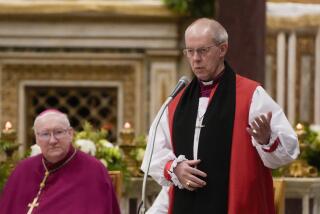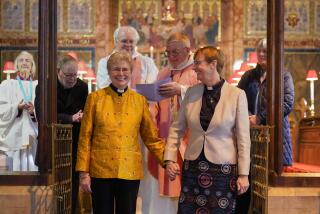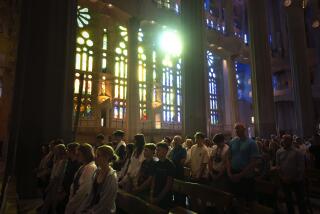Shepherds of Souls or Keepers of Buildings? : Preservation: Church of England clergy are growing weary of the burden of raising money to care for nation’s historic religious structures.
- Share via
LONDON — It’s a nightmare of historic proportions.
Clergy of the Church of England are finding themselves reduced to the role of custodians of the country’s huge repository of historic churches, responsible for the upkeep and maintenance of thousands of priceless buildings and monuments.
Of the church’s 16,364 ecclesiastical buildings, about 13,000 are officially listed as having special architectural or historic significance. Most date from before the Reformation, and the cost of maintaining them approaches $175 million a year.
Such duties are increasingly frustrating for Anglican clerics, who believe they should be tending to their spiritual flocks rather than the buildings that shelter them.
“We cannot be a church for the sake of its buildings,” Bishop Gavin Reid of Maidstone told a group of Anglican evangelicals recently. Although England has some of Europe’s most beautiful and historic churches the cost of maintaining them “is strangling the life of some of our village congregations,” Reid said.
Just as serious, Reid said, is that the burden of building upkeep distorts the message of Christianity. “All too often the symbol of the cross is replaced by the symbol of the fund-raising thermometer,” he said.
The question becomes most acute with England’s medieval cathedrals--vast structures that require a vast amount of money to restore stonework and artifacts eroded by time and acid rain.
But as dramatic as the sums involved may be--Winchester, for example, has raised nearly $11 million for capital projects, and Salisbury more than $10 million--the real difficulty can lie in covering day-to-day operating costs.
“If we had a crack in the dome tomorrow we’d be able to raise ($8 million) in a week,” said Canon Christopher Hill of St. Paul’s, the Wren masterpiece that is London’s cathedral. “But you can’t raise (the money) to pay the vergers and all the other staff you need to run the cathedral.”
About half the country’s cathedrals are running at a deficit, said the Dean of Winchester, the Very Rev. Trevor Beeson. His cathedral finds itself about $150,000 in the red each year. Keeping the building open from 7:30 a.m. to 6:30 p.m. every day of the year costs $1.3 million annually.
Many cathedrals ask visitors to make a donation--$3 in Winchester’s case--but many visitors don’t contribute, leading some churches to be more assertive in seeking donations.
Two of England’s Anglican cathedrals have imposed an admission charge, which does not apply to those attending services or simply wishing to pray. It is difficult, if not impossible, for cathedrals to disentangle their role as a tourist attraction from that of a place of pilgrimage.
The financial pressures on cathedrals have occasionally led to rather desperate steps. In 1988, Hereford Cathedral created a furor with plans to raise nearly $11 million by selling its greatest treasure, the Mappa Mundi, a 13th-Century map of the world with Jerusalem at the center. The artifact remains at Hereford, where visitors now pay $2.50 to see it.
Lincoln Cathedral lost about $88,000 when it sent its copy of the Magna Carta--the 13th-Century treaty between King John and his barons--to an exhibition in Australia, escorted by the cathedral treasurer, his wife, daughter and a family friend.
To ease the financial strain, the government has started providing grants for cathedrals through English Heritage, the statutory body that is responsible for the country’s ancient monuments and historic buildings.
More to Read
The biggest entertainment stories
Get our big stories about Hollywood, film, television, music, arts, culture and more right in your inbox as soon as they publish.
You may occasionally receive promotional content from the Los Angeles Times.










